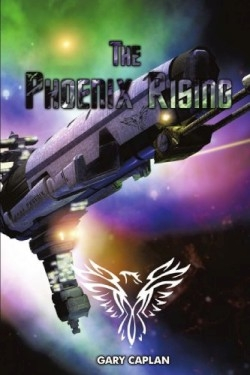The Phoenix Rising
Robert Allen Sheppard is an officer in the fleet of the Alliance of Worlds who is on the fast track to an admiralship. He is dealing with a complex diplomatic and military situation exacerbated by the influx of advanced espionage technology. The Viridian are reptilian aliens with whom the Alliance has a truce, and hostilities between them begin when an Alliance starbase drifts into Viridian territory. Other cultures act to exploit tense relations between the two groups, and an isolated event becomes an interstellar incident.
In this short novel, physician Gary Caplan combines elements from Star Wars with detailed references to the various Star Trek series, demonstrating his devotion to the franchise. He knows the Star Trek universe from front to back, which is obvious from his references to individual characters, political dynamics, standards of ship naming, alien psychologies, space quadrant naming, and industrial design and technology. From Star Wars, he borrows the Jedi concept, calling his characters “Star Knights” who have the ability to use “metaphysical or psionic abilities and disciplines.”
On the whole, although the combination of concepts is new, this novel is unoriginal. Chapter titles are excessively wordy, like “Gathering Hydrogen and Arranging Tasks,” or give away the central event and destroy any sense of suspense, like “The Loss of the Karratin Medical and Science Ships.” Caplan should have stuck with numbers, as writers use in the Star Trek novelizations. He also digresses at some points, especially in the chapter about sickbay.
Despite the book’s stylistic and structural weaknesses, Caplan demonstrates his intelligence when he implicitly questions the structure of the universes he is borrowing from; the best example comes from chapter ten:
“I will also have to talk to Captain Wilder about his apparent predilection for humans or humanoids on his bridge. Is it for the same basic reason that I employed: to simply avoid cultural problems in the nerve center of a starship and prevent environmental compatibility issues in crews with temperature, humidity, or atmosphere differences?” Despite his awkward phrasing, Caplan entertainingly engages with an aspect of the Star Trek universe evident across all five series.
Although his writing style needs improvement, Caplan would ultimately be better served if he were to focus less on emulating specific elements of the fantastic worlds he admires and more on building his own. He has an impressive academic record, and there are many interesting trends in public health and medicine at the present time whose futures are worthy of prognostication.
Disclosure: This article is not an endorsement, but a review. The publisher of this book provided free copies of the book and paid a small fee to have their book reviewed by a professional reviewer. Foreword Reviews and Clarion Reviews make no guarantee that the publisher will receive a positive review. Foreword Magazine, Inc. is disclosing this in accordance with the Federal Trade Commission’s 16 CFR, Part 255.

